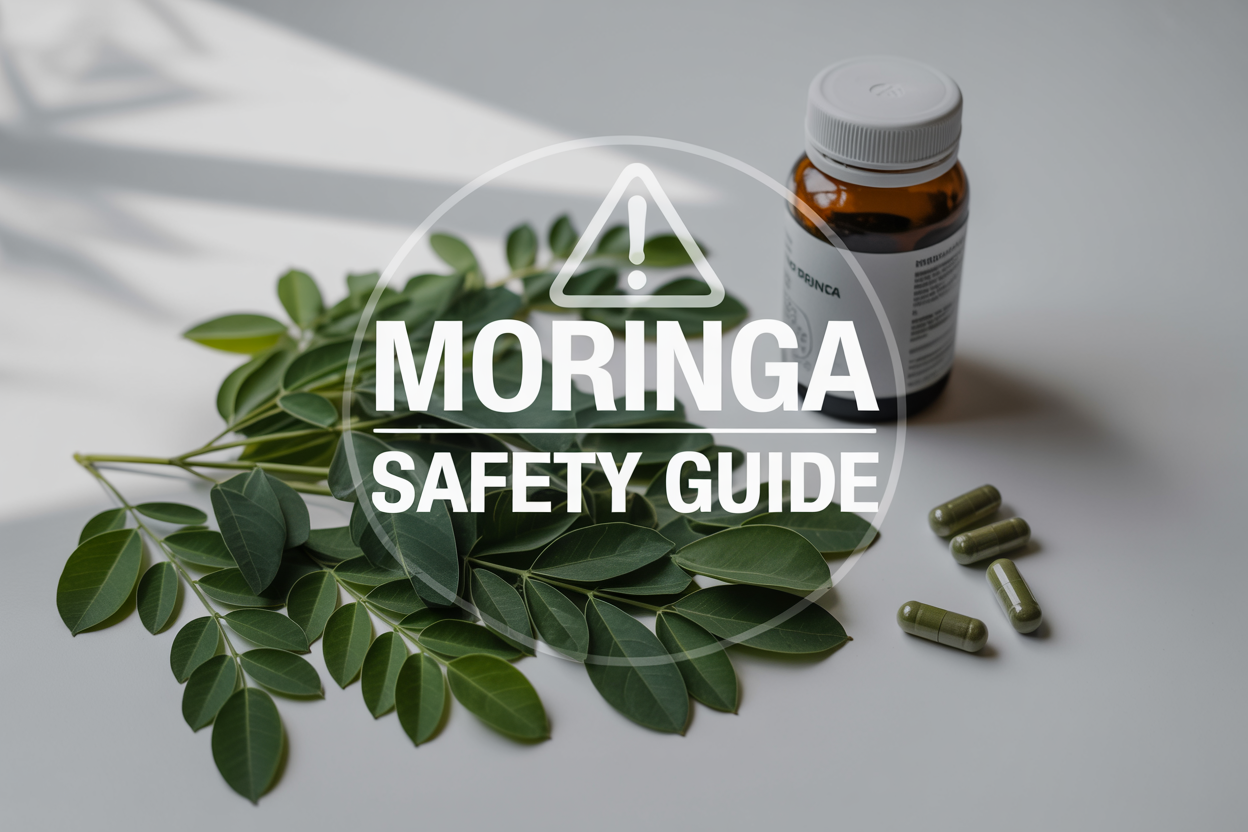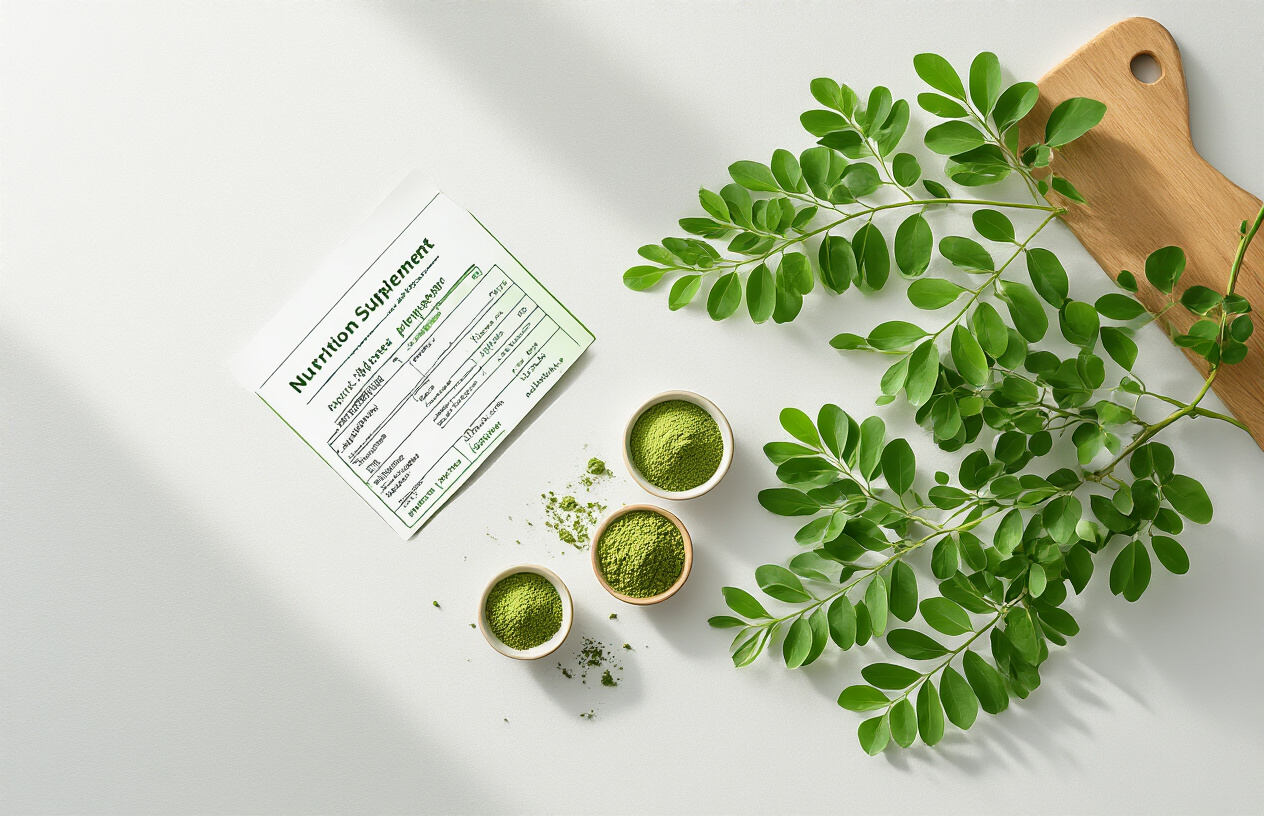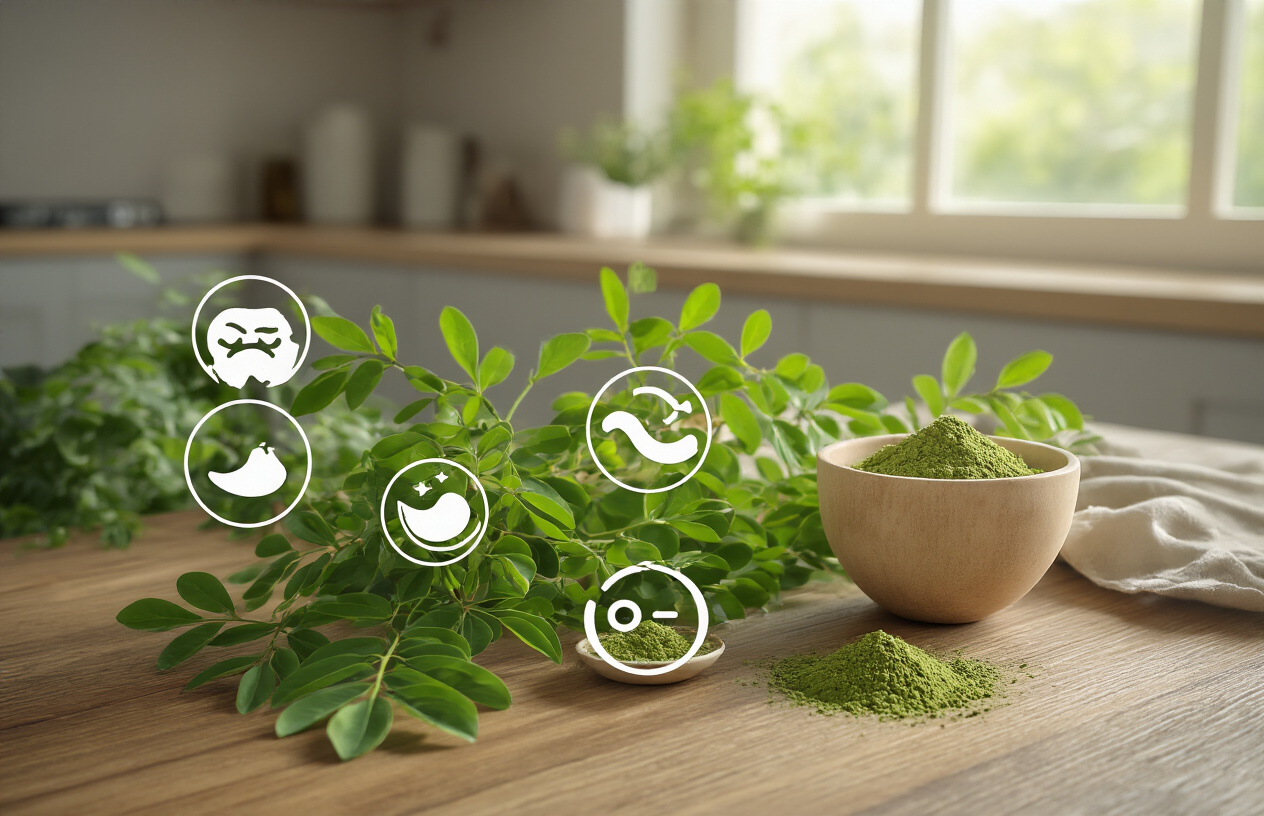
Moringa has earned its reputation as a superfood, but you might be wondering about moringa side effects before adding this green powder to your daily routine. If you’re someone who values natural health supplements but wants to make informed decisions about what goes into your body, you’re in the right place.
While moringa leaf offers impressive nutritional benefits, it’s not risk-free for everyone. Some people experience digestive issues, blood sugar changes, or interactions with medications. Others need to be extra careful due to pregnancy, existing health conditions, or the medications they’re taking.
In this guide, you’ll discover the most common side effects people report when taking moringa, plus you’ll learn who should think twice before trying this popular supplement. We’ll also cover safe dosage guidelines so you can enjoy moringa’s benefits without putting your health at risk. By the end, you’ll know exactly how to approach moringa leaf consumption safely and confidently.
Understanding Moringa Leaf and Its Nutritional Profile

Essential vitamins and minerals found in moringa leaves
Your moringa leaves pack an impressive nutritional punch that puts many vegetables to shame. You’ll find exceptionally high levels of vitamin C – actually seven times more than oranges contain. This makes moringa an excellent choice for supporting your immune system naturally.
The vitamin A content is equally remarkable, with four times more than carrots provide. Your eyes, skin, and immune function all benefit from this powerhouse vitamin. You’re also getting substantial amounts of vitamin E, which acts as a potent antioxidant protecting your cells from damage.
When it comes to minerals, your moringa leaves deliver calcium levels that exceed what you’d find in milk – about four times more, in fact. Your bones and teeth will thank you for this natural calcium boost. The iron content is particularly noteworthy, providing three times more than spinach, making it valuable if you’re dealing with iron deficiency.
You’ll also discover significant amounts of potassium, magnesium, and zinc in your moringa leaves. Potassium supports your heart health and helps regulate blood pressure, while magnesium plays crucial roles in muscle and nerve function. The zinc content supports your immune system and helps with wound healing.
Protein content and amino acid composition
Your moringa leaves contain all nine essential amino acids, making them a complete protein source – something rare in the plant kingdom. This means you’re getting protein quality comparable to what you’d find in animal products, but from a plant-based source.
The protein content in dried moringa leaves reaches about 25-30% by weight, which rivals many legumes and nuts. You’ll find particularly high levels of leucine, isoleucine, and valine – the branched-chain amino acids your muscles need for repair and growth.
What makes your moringa protein special is its digestibility. Your body can easily break down and utilize these amino acids, making them readily available for various bodily functions. You’re getting lysine levels that exceed what most grains provide, helping to balance out cereal-based diets.
The methionine and cysteine content supports your liver’s detoxification processes, while the tryptophan can help improve your sleep quality and mood regulation. This amino acid profile makes moringa particularly valuable if you’re following a vegetarian or vegan diet.
Antioxidant properties and their health benefits
Your moringa leaves contain over 40 different antioxidant compounds, creating a powerful defense system against cellular damage. The primary antioxidants include quercetin, chlorogenic acid, and beta-carotene, each offering unique protective benefits for your health.
Quercetin helps reduce inflammation throughout your body and may support heart health by helping to lower blood pressure. You’ll also benefit from its natural antihistamine properties, which can help with seasonal allergies.
The chlorogenic acid in your moringa leaves works similarly to what you’d find in coffee beans, helping to regulate blood sugar levels and potentially supporting weight management efforts. This compound also provides liver-protective benefits.
You’re getting substantial amounts of vitamin C and vitamin E working together synergistically. This combination enhances the antioxidant effect, providing better protection than either vitamin would offer alone. The beta-carotene converts to vitamin A in your body as needed, supporting eye health and immune function.
These antioxidants work together to combat free radicals that can accelerate aging and contribute to chronic diseases. Your cells receive comprehensive protection that may help reduce your risk of heart disease, certain cancers, and neurodegenerative conditions.
How moringa compares to other superfoods
Your moringa leaves outperform many popular superfoods in several nutritional categories. Compared to kale, you’re getting significantly more vitamin C, calcium, and protein from moringa. While kale provides about 80mg of vitamin C per 100g, your moringa delivers over 200mg.
When you compare moringa to spirulina, another protein-rich superfood, you’ll find that moringa provides a more complete amino acid profile and higher levels of certain vitamins. However, spirulina does offer more B12, so combining both can create a more comprehensive nutritional approach.
| Nutrient | Moringa (100g dried) | Spinach (100g) | Kale (100g) | Spirulina (100g) |
|---|---|---|---|---|
| Vitamin C | 220mg | 28mg | 93mg | 10mg |
| Calcium | 2000mg | 99mg | 150mg | 120mg |
| Iron | 25mg | 2.7mg | 1.5mg | 28mg |
| Protein | 27g | 2.9g | 4.3g | 57g |
Your moringa also provides more variety in its nutrient profile compared to single-focus superfoods like goji berries or acai. While these berries excel in specific antioxidants, moringa gives you a broader spectrum of vitamins, minerals, and beneficial compounds in one source.
The bioavailability of nutrients in moringa often exceeds what you’d get from synthetic supplements, since the natural matrix of compounds works together to enhance absorption and utilization in your body.
Common Side Effects of Moringa Leaf Consumption

Digestive Issues Including Nausea and Stomach Upset
When you first start taking moringa leaf supplements or consuming the powder, your digestive system might not react as smoothly as you’d expect. Many people experience mild to moderate stomach discomfort, especially when taking moringa on an empty stomach. You might notice nausea, cramping, or general digestive upset during your first few days of consumption.
The high fiber content in moringa leaves can trigger these digestive side effects if your body isn’t accustomed to sudden increases in fiber intake. You could experience loose stools, diarrhea, or conversely, constipation as your system adjusts. Some users report a metallic taste in their mouth or heartburn after consuming moringa supplements.
To minimize these moringa side effects, start with smaller doses and gradually increase your intake. Taking moringa with food rather than on an empty stomach can significantly reduce nausea and stomach irritation. Your digestive system typically adapts within a week or two of consistent use.
Blood Sugar Fluctuations and Hypoglycemia Risks
Moringa’s blood sugar-lowering properties can become problematic if you’re not careful with dosage or timing. While this superfood can help manage diabetes when used properly, it may cause your blood glucose levels to drop too low, leading to hypoglycemia.
You might experience symptoms like dizziness, shakiness, sweating, confusion, or sudden fatigue if moringa causes your blood sugar to plummet. This risk increases significantly if you’re already taking diabetes medications or have naturally low blood sugar levels.
| Risk Factors | Symptoms to Watch |
|---|---|
| Diabetes medications | Dizziness, shakiness |
| Fasting states | Confusion, sweating |
| Pre-existing hypoglycemia | Rapid heartbeat, anxiety |
| High moringa doses | Weakness, irritability |
Monitor your blood sugar levels closely when incorporating moringa into your routine, especially during the first few weeks. Consider testing before and after consumption to understand how your body responds.
Potential Interactions with Blood Pressure Medications
Your blood pressure medications might not work as expected when combined with moringa supplements. This superfood naturally lowers blood pressure, which sounds beneficial but can create dangerous interactions with your prescribed medications.
If you’re taking ACE inhibitors, beta-blockers, or other antihypertensive drugs, adding moringa could cause your blood pressure to drop too low. You might experience lightheadedness when standing up, fatigue, or even fainting spells as your blood pressure becomes unstable.
The moringa leaf safety concern becomes serious when you consider that blood pressure that’s too low can be just as dangerous as high blood pressure. Your organs need adequate blood flow to function properly, and excessive drops can compromise their performance.
Always consult your healthcare provider before adding moringa to your supplement routine if you’re on blood pressure medications. They may need to adjust your prescription dosages or monitor you more closely for adverse effects.
Allergic Reactions and Skin Sensitivities
Although rare, some people develop allergic reactions to moringa leaves or supplements. You might notice skin rashes, hives, or itching shortly after consumption. More severe reactions can include swelling of your face, lips, or throat, which requires immediate medical attention.
Topical application of moringa oil or direct contact with fresh leaves can trigger contact dermatitis in sensitive individuals. Your skin might become red, inflamed, or develop small bumps where the moringa made contact.
Cross-reactivity with other plant allergens is possible, especially if you’re already allergic to plants in the Moringaceae family. Some people with tree nut allergies report sensitivity to moringa, though scientific evidence for this connection remains limited.
Watch for these warning signs of allergic reactions:
- Skin rashes or hives
- Difficulty breathing
- Swelling of face or throat
- Severe itching or burning sensations
- Digestive distress accompanied by skin reactions
If you experience any severe allergic symptoms, discontinue moringa use immediately and seek medical care. Start with very small amounts to test your body’s reaction before increasing to recommended dosages.
Who Should Exercise Caution with Moringa

Pregnant and Breastfeeding Women Safety Concerns
If you’re pregnant or nursing, you need to approach moringa with extra care. While moringa leaf safety is generally well-documented for most adults, pregnancy changes everything about how your body processes supplements and foods.
The bark, roots, and flowers of the moringa tree contain compounds that could potentially trigger uterine contractions. Though moringa leaves are considered safer than other parts of the plant, research on moringa side effects during pregnancy remains limited. Your developing baby depends entirely on what you consume, making any uncertainty a valid reason for caution.
During breastfeeding, substances from moringa can pass through your breast milk to your baby. Since infants have immature digestive and metabolic systems, even small amounts of certain compounds could affect them differently than they would affect you. The lack of comprehensive studies on moringa supplement side effects in nursing mothers means you’re essentially in uncharted territory.
Before adding moringa to your routine during pregnancy or breastfeeding, consult your healthcare provider. They can evaluate your specific situation and help you weigh the potential moringa superfood risks against any possible benefits.
Individuals with Diabetes and Blood Sugar Management
Your blood sugar management becomes more complex when you add moringa to the mix. Moringa leaves contain compounds that can naturally lower blood glucose levels, which sounds beneficial but can create serious complications if you’re already taking diabetes medications.
When moringa’s blood sugar-lowering effects combine with your prescribed medications, you risk experiencing dangerous hypoglycemia (extremely low blood sugar). This condition can cause dizziness, confusion, sweating, and in severe cases, loss of consciousness or seizures.
If you’re managing diabetes with insulin or medications like metformin, glipizide, or glyburide, moringa consumption safety requires careful monitoring. You’ll need to track your blood sugar more frequently and potentially adjust your medication dosages under medical supervision.
The timing of moringa consumption also matters. Taking it close to meals or medication times can amplify its effects, making blood sugar drops more pronounced and unpredictable.
| Blood Sugar Monitoring Tips with Moringa |
|---|
| Check levels before and after moringa consumption |
| Monitor for symptoms of hypoglycemia |
| Keep glucose tablets or snacks nearby |
| Record patterns in a diabetes journal |
Work closely with your endocrinologist or primary care physician to create a monitoring plan that accounts for moringa’s potential effects on your blood sugar control.
People Taking Prescription Medications for Chronic Conditions
Your prescription medications can interact with moringa in ways that change how both substances work in your body. These moringa adverse effects aren’t always obvious immediately, making them particularly concerning for long-term medication users.
Moringa can affect how quickly your liver processes certain drugs, potentially making some medications less effective or others more potent than intended. Blood thinners like warfarin are especially problematic, as moringa’s vitamin K content can interfere with the medication’s ability to prevent blood clots.
If you take medications for high blood pressure, moringa’s natural blood pressure-lowering properties could cause your pressure to drop too low when combined with antihypertensive drugs. This can lead to dizziness, fainting, or more serious cardiovascular complications.
Heart medications, thyroid treatments, and immunosuppressants each carry their own interaction risks with moringa. The supplement can alter absorption rates, metabolism speed, or excretion patterns of these critical medications.
High-Risk Medication Categories:
- Anticoagulants and blood thinners
- Blood pressure medications
- Diabetes medications
- Thyroid medications
- Heart rhythm medications
- Immunosuppressive drugs
Before starting moringa, provide your doctor with a complete list of all medications, supplements, and over-the-counter drugs you take. They may recommend spacing out dosing times, adjusting medication levels, or choosing alternative supplements that won’t interfere with your treatment plan.
Regular monitoring becomes essential when combining moringa with prescription medications. Your doctor might order more frequent blood tests to check medication levels, organ function, or specific health markers related to your chronic condition.
Proper Dosage Guidelines for Safe Consumption

Recommended daily intake amounts for beginners
Starting your journey with moringa requires a cautious approach to avoid unwanted side effects. If you’re new to this superfood, begin with just 1/2 to 1 teaspoon of moringa powder daily. This translates to approximately 2-4 grams, which gives your body time to adjust to moringa’s potent nutritional profile without overwhelming your system.
For moringa capsules, stick to one 400-500mg capsule per day initially. Fresh moringa leaves can be consumed in small amounts – about 5-10 leaves daily when starting out. Tea preparations should be limited to one cup per day, using no more than 1 teaspoon of dried moringa leaves.
Your body needs time to adapt to moringa’s high vitamin and mineral content. Starting with these conservative amounts helps you gauge your individual tolerance while still reaping the superfood’s benefits.
How to gradually increase dosage safely
After successfully tolerating moringa for 1-2 weeks, you can slowly increase your intake. Add another 1/2 teaspoon of powder or one additional capsule every week until you reach your desired maintenance dose.
Monitor your body’s response during each increase. If you experience digestive discomfort, headaches, or unusual fatigue, scale back to your previous dose and maintain that level for another week before attempting to increase again.
The gradual approach prevents moringa side effects and allows your digestive system to adapt. Most people find their sweet spot within 2-4 weeks of consistent, careful dosing adjustments.
Different forms of moringa and their potency levels
Understanding potency variations helps you make informed decisions about moringa dosage guidelines. Here’s how different forms compare:
| Form | Potency Level | Typical Daily Dose | Notes |
|---|---|---|---|
| Powder | High | 1-2 teaspoons | Most concentrated nutrients |
| Capsules | Medium-High | 2-4 capsules | Convenient, controlled dosing |
| Fresh Leaves | Medium | 20-40 leaves | Milder, food-like experience |
| Tea | Low-Medium | 1-2 cups | Gentlest introduction |
| Oil | Variable | 1-2 teaspoons | Primarily for topical use |
Moringa powder packs the most nutritional punch because it’s concentrated. Fresh leaves offer a gentler introduction but require larger quantities to achieve similar benefits. Capsules provide consistent dosing without the earthy taste that some find challenging.
Signs you may be taking too much moringa
Your body will signal when you’ve exceeded your optimal moringa dosage. Watch for these warning signs that indicate you should reduce your intake:
Digestive issues top the list of moringa adverse effects from overconsumption. You might experience nausea, diarrhea, stomach cramps, or excessive gas. These symptoms typically appear within hours of taking too much moringa.
Sleep disturbances can occur due to moringa’s energizing properties. If you’re experiencing insomnia, restlessness, or feeling overly stimulated, especially when taking moringa later in the day, consider reducing your dose or timing.
Headaches and dizziness sometimes develop when your system is overwhelmed by moringa’s nutrient density. These symptoms often accompany nausea and indicate your body needs a break from supplementation.
Blood sugar fluctuations may occur in sensitive individuals. If you’re monitoring blood glucose levels and notice unusual drops or spikes after starting moringa, consult your healthcare provider about appropriate moringa leaf safety measures.
Skin reactions like rashes or itching, though rare, can signal an allergic response or overconsumption. Stop using moringa immediately if these symptoms appear and seek medical advice if they persist.
When you notice any of these signs, reduce your moringa intake by half for several days. If symptoms continue, discontinue use and consult a healthcare professional about moringa supplement side effects specific to your situation.
Maximizing Benefits While Minimizing Risks

Best practices for incorporating moringa into your diet
Start small when adding moringa to your routine. Begin with just half a teaspoon of moringa powder daily and gradually increase to 1-2 teaspoons over several weeks. This approach helps your body adjust and reduces the risk of moringa side effects like digestive upset.
Mix moringa powder into smoothies, yogurt, or juice rather than taking it straight. The bitter taste becomes more palatable when combined with sweet fruits like banana or mango. You can also sprinkle it over salads or stir it into soups after cooking to preserve heat-sensitive nutrients.
Fresh moringa leaves work wonderfully in curries, stir-fries, and steamed vegetable dishes. Cook them briefly to maintain their nutritional value while making them easier to digest. Avoid boiling moringa leaves for extended periods as this destroys valuable vitamins and minerals.
Consider cycling your moringa intake – take it for 2-3 weeks, then break for a week. This prevents your body from becoming too accustomed to the supplement and maintains its effectiveness while minimizing potential moringa adverse effects.
Timing your moringa intake for optimal absorption
Take moringa on an empty stomach in the morning for maximum nutrient absorption. The concentrated vitamins and minerals absorb more efficiently when your digestive system isn’t processing other foods. Wait at least 30 minutes before eating breakfast to give your body time to process the nutrients.
If you experience stomach discomfort with morning doses, try taking moringa with a light meal instead. A small piece of fruit or a handful of nuts can buffer the intensity while still allowing good absorption.
Avoid taking moringa late in the evening. Its energizing properties might interfere with your sleep quality. The natural caffeine-like compounds in moringa can keep you alert when you’re trying to wind down for the night.
Space out multiple doses throughout the day if you’re taking larger amounts. Rather than consuming 2 teaspoons at once, split it into two 1-teaspoon servings – one in the morning and one in the afternoon.
Quality indicators when purchasing moringa products
Look for organic certification when shopping for moringa products. Organic moringa ensures you’re not consuming pesticides or chemical fertilizers that could add to moringa health warnings or safety concerns. Check the packaging for USDA Organic or equivalent certification symbols.
Choose moringa powder with a vibrant green color. Fresh, high-quality moringa maintains its bright green appearance. Brown or yellowish powder often indicates old product or poor processing methods that may have destroyed beneficial compounds.
Check the ingredient list carefully. Pure moringa products should contain only moringa leaf powder with no fillers, artificial colors, or preservatives. Some manufacturers add unnecessary ingredients that could trigger allergic reactions or reduce the product’s effectiveness.
Research the source location. Moringa grown in its native regions like India, Africa, and Southeast Asia typically offers superior nutritional profiles compared to products from other climates. The packaging should clearly state the origin country.
Examine the packaging date and expiration information. Fresh moringa powder loses potency over time, so choose products with recent packaging dates and proper storage recommendations.
| Quality Factor | What to Look For | What to Avoid |
|---|---|---|
| Color | Vibrant green | Brown or yellow tinge |
| Texture | Fine, smooth powder | Clumpy or gritty texture |
| Smell | Fresh, slightly grassy | Musty or sour odors |
| Packaging | Airtight, light-proof containers | Clear plastic or damaged seals |
When to consult healthcare professionals before use
Contact your doctor before starting moringa if you take prescription medications. Moringa can interact with blood pressure medications, diabetes drugs, and blood thinners, potentially altering their effectiveness or creating dangerous combinations.
Pregnant and breastfeeding women should always discuss moringa leaf safety with their healthcare provider first. While moringa contains valuable nutrients, certain compounds in the roots and bark can be harmful during pregnancy, and even leaf consumption needs professional guidance.
People with autoimmune conditions like rheumatoid arthritis, lupus, or multiple sclerosis need medical supervision before trying moringa. The immune-boosting properties that make moringa beneficial for most people could potentially overstimulate an already overactive immune system.
If you have a history of kidney stones, get medical approval before using moringa supplements. The high oxalate content in moringa leaves might contribute to stone formation in susceptible individuals.
Schedule a consultation if you experience persistent side effects after starting moringa. While mild digestive changes are normal initially, ongoing nausea, headaches, or unusual symptoms warrant professional evaluation to rule out allergic reactions or underlying health issues that make moringa unsuitable for you.

You’ve learned that moringa leaf can be an incredible addition to your wellness routine, packed with vitamins, minerals, and antioxidants that support your overall health. However, like any potent superfood, it comes with potential side effects that you need to be aware of. From digestive upset and blood sugar changes to possible interactions with medications, moringa requires respect and careful consideration before you add it to your daily regimen.
The key to safely enjoying moringa’s benefits lies in starting small, listening to your body, and consulting with your healthcare provider if you’re pregnant, breastfeeding, taking medications, or managing chronic health conditions. Remember that “natural” doesn’t always mean risk-free, and what works wonderfully for others might not be the right fit for your unique situation. Begin with small doses, pay attention to how you feel, and adjust accordingly. When used thoughtfully and responsibly, moringa can be a powerful ally in your health journey without compromising your safety.
